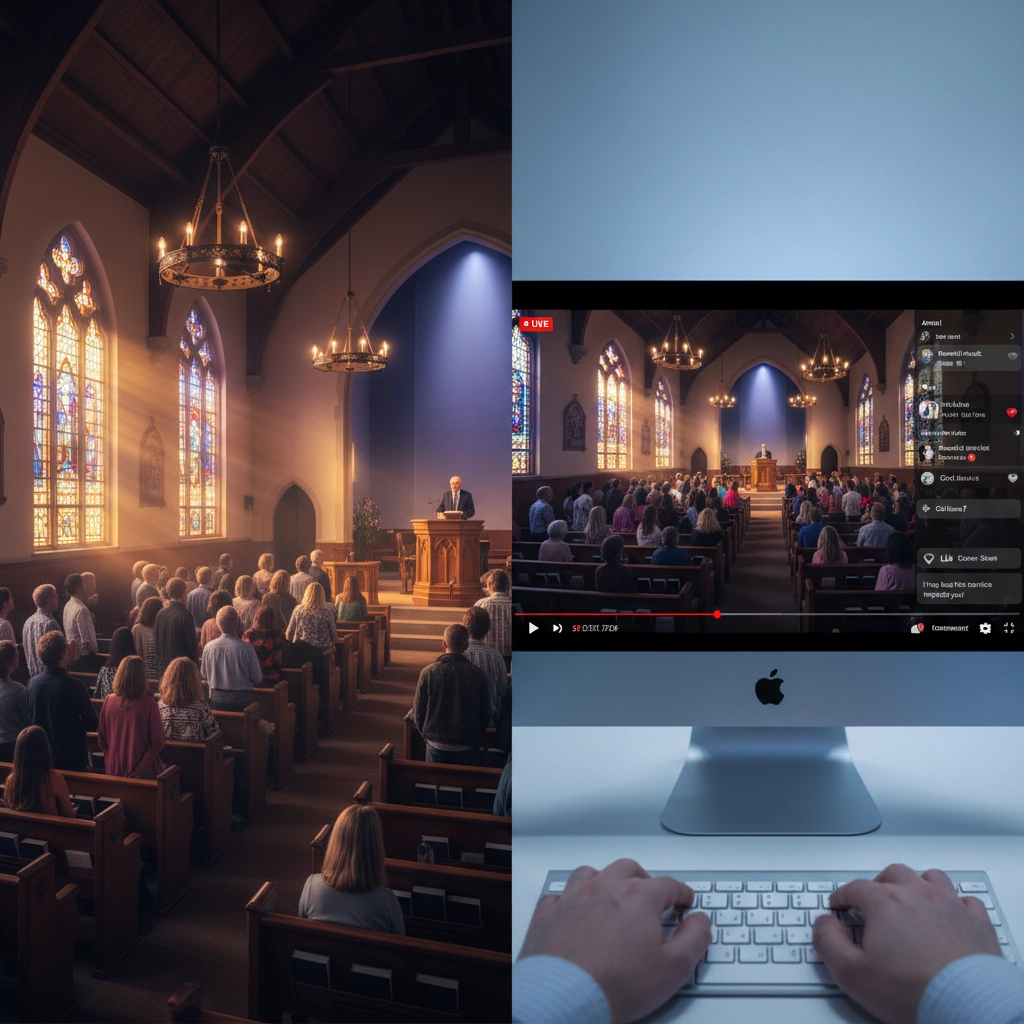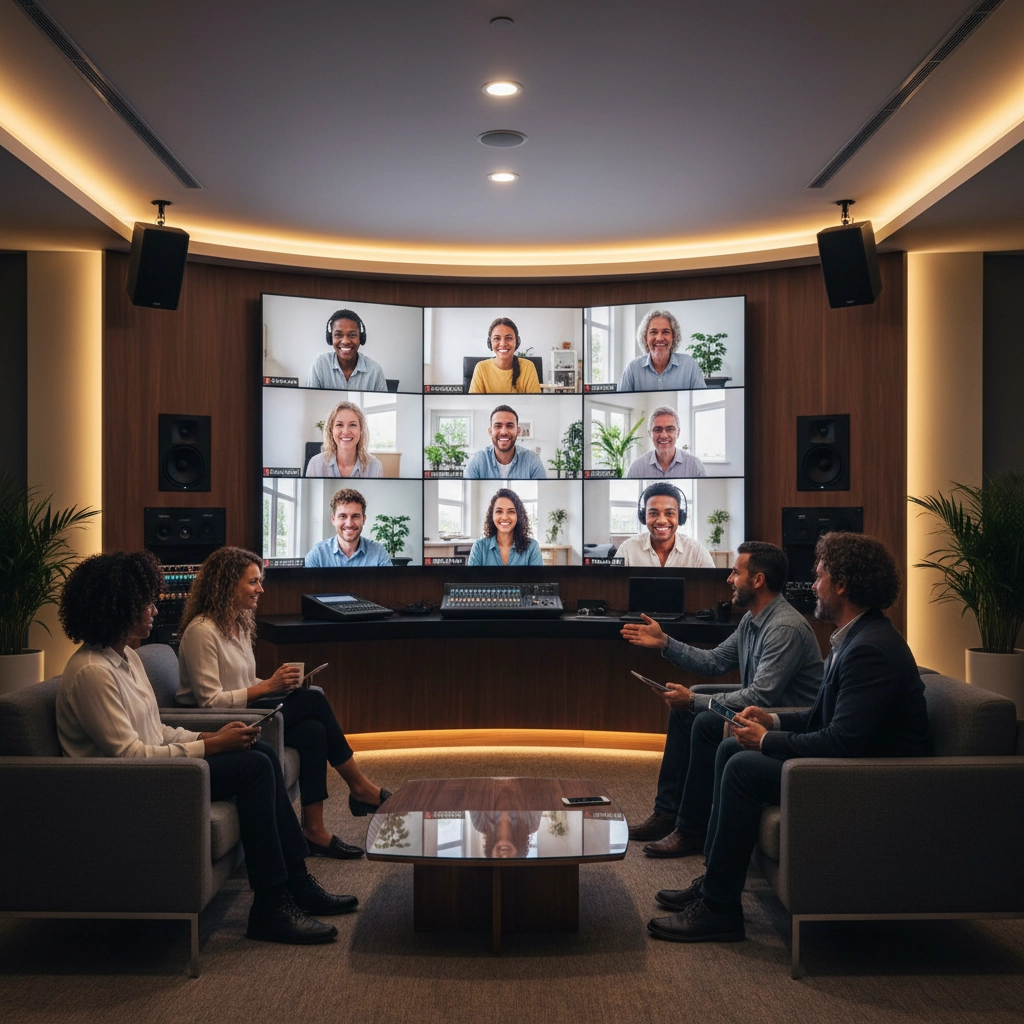How to Create Hybrid Worship Experiences That Actually Engage Both In-Person and Online Members
- davidau
- Sep 22
- 4 min read
The pandemic forced churches into hybrid worship, but many are still struggling to make it work well. Too often, online viewers feel like they're watching a TV show instead of participating in worship, while in-person attendees wonder if all the cameras and tech are distracting from the actual service.
Here's the truth: hybrid worship isn't just streaming your regular service online. It's creating one unified experience that actively engages everyone, regardless of where they're sitting. When done right, it doesn't split your congregation: it strengthens it.
Start with the Right Technical Foundation
Audio-Visual Equipment That Actually Works
Your streaming quality directly impacts how engaged your online audience can be. Fuzzy video and choppy audio will kill engagement faster than anything else. You need HD cameras that can handle your lighting conditions, professional audio systems that capture clear sound, and reliable streaming platforms that won't crash during your Easter service.
If you're just starting out, one good HD camera might work, but consider multiple cameras and a video switcher for more dynamic coverage. Your online viewers should feel like they're getting the best seat in the house, not watching security footage.

Choose Platforms That Enable Real Interaction
Not all streaming platforms are created equal. Look for ones that offer chat functions, polls, and question submission features. These aren't nice-to-haves: they're essential tools for engagement. Facebook Live, YouTube Live, and dedicated church streaming platforms each have different interactive capabilities, so choose based on what your community actually needs.
Design Your Service for Both Audiences Simultaneously
Speak to Everyone from the Start
When you welcome people to worship, explicitly acknowledge those watching online. Don't just say "Good morning, everyone": say "Good morning to those of you here in the sanctuary and those of you joining us online." Provide ways for online viewers to "check in," share prayer requests, or contribute to the offering just like in-person attendees.
This isn't about political correctness: it's about preventing the creation of two separate congregations. Many churches accidentally treat their livestream as an afterthought, and online viewers can tell.
Account for What Translates (and What Doesn't)
What looks perfect in person might be a disaster online. Check for lighting issues that create shadows on your speakers, background noise that gets picked up by your microphones, and visual distractions that work fine in person but look chaotic on camera.
Be aware of "dead air" moments too. In-person attendees can see what's happening during setup or transitions, but online viewers just see awkward silence or empty stages.

Create Active Engagement, Not Passive Viewing
Make Online Participation Real
Incorporate your online audience into the actual service elements. During prayer time, invite online viewers to submit prayer requests in the chat. For worship songs, encourage them to respond in the comments. During the sermon, give them ways to ask questions or share insights in real-time.
Assign someone to monitor and respond to chat messages: someone who can greet people as they join online, just like greeters welcome people at the door. This person should be part of your ministry team, not just a tech volunteer.
Keep Communication Clear for Everyone
Avoid church jargon and inside references that might confuse newcomers joining virtually. When you mention the fellowship hall or reference a church program, provide context. Always include your website and contact information so online participants can easily follow up.
Remember, your online audience includes both regular members and people discovering your church for the first time. Make sure both groups can fully understand and participate.
Build Community Beyond the Service
Plan for Post-Service Connection
Your engagement strategy can't end when the service does. Have specific follow-up plans for online attendees. This might include emailing sermon discussion questions, hosting virtual coffee hours, or creating online small groups for people who primarily attend digitally.
The goal is continuing the relationship beyond Sunday morning. Online attendees should have just as many opportunities for deeper connection as in-person members.

Handle Privacy and Safety Thoughtfully
Be careful about personal information shared during prayer time or announcements. Your service reaches beyond your known congregation through social media platforms. Instead of sharing specific personal details that could compromise privacy, develop private systems for sensitive prayer requests with your prayer team.
This isn't about being secretive: it's about being responsible with the broader reach your hybrid platform provides.
Train Your Team for Digital Ministry
Develop Digital Hospitality Skills
Your volunteers need training in digital hospitality, not just traditional hospitality. This includes understanding how to engage online participants, managing chat interactions professionally, and creating welcoming virtual environments.
The person managing your online chat needs different skills than your physical greeters, but they're just as important to your ministry's success.
Ensure Consistent Messaging Across Platforms
Your staff should deliver the same quality message whether someone's sitting in pew 5 or watching from their kitchen table. This requires understanding how communication works differently in online vs. in-person contexts while maintaining the same spiritual depth and authenticity.
Think Long-Term Strategy, Not Quick Fix
Create Dual Pathways for Spiritual Growth
Develop both physical and digital discipleship opportunities. This means online small groups, virtual mentoring programs, and digital resource libraries alongside your traditional in-person offerings. People should be able to grow spiritually regardless of how they primarily connect with your church.
Don't just duplicate your in-person programs online: create digital-native ministry opportunities that work specifically for online participants.

Regularly Evaluate and Improve
Treat hybrid worship as ongoing ministry development, not a temporary accommodation. Regularly gather feedback from online participants about their experience. What's working? What feels disconnected? How can you better serve both audiences?
The churches succeeding at hybrid worship are the ones constantly refining their approach based on real feedback from real people.
Making It All Work Together
The ultimate goal isn't accommodating different preferences: it's creating one unified community where physical location doesn't determine spiritual engagement quality. When hybrid worship is done well, online and in-person attendees feel equally valued, equally engaged, and equally connected to the broader church community.
This requires intentional effort, proper equipment, and ongoing attention. But for churches willing to invest in doing it right, hybrid worship doesn't just expand their reach: it deepens their community impact and creates more pathways for meaningful spiritual connection.
Your congregation is bigger than your building. Hybrid worship helps you serve all of it well.
If you're ready to upgrade your church's AV systems to support truly engaging hybrid worship, contact our team at Timato Systems for a consultation tailored to your specific ministry needs.



Comments